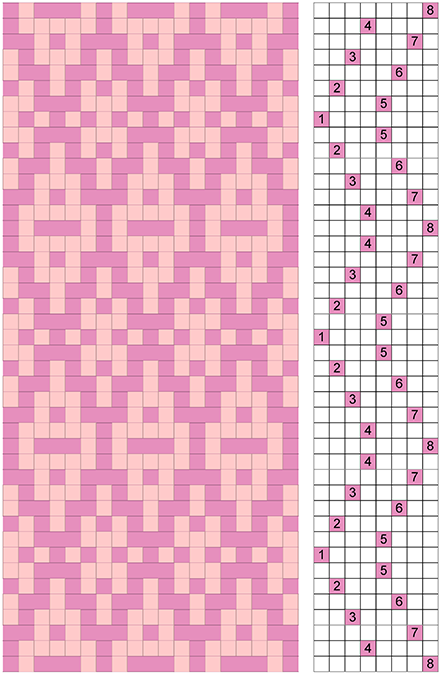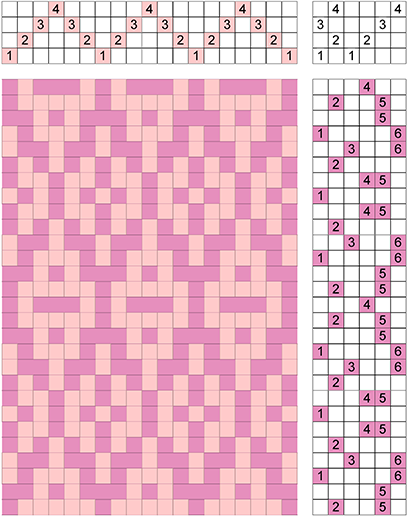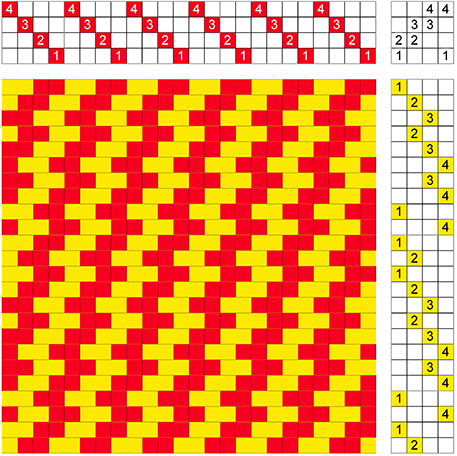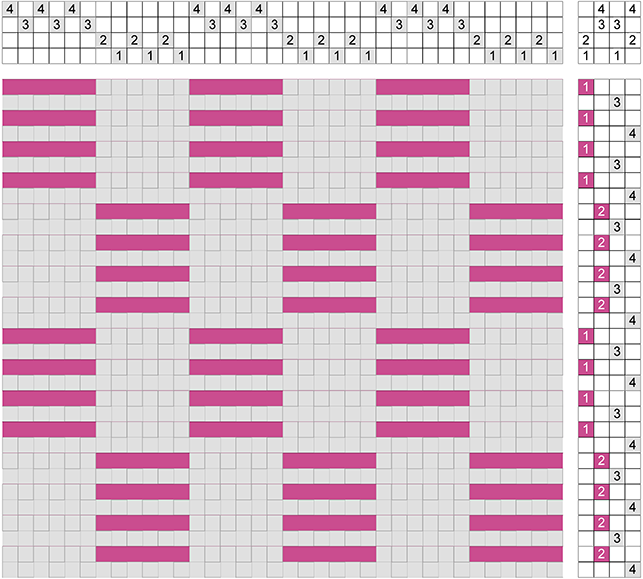Turning a Draft
Marcy Petrini
May, 2020
To turn a draft means exactly what the name implies: the draft is rotated on its side so that the threading becomes the treadling and the treadling becomes the threading. The tie-up is transposed as we shall see.
There are several reasons to turn a draft: 1) to reduce the number of shafts needed for a pattern; 2) to simplify the treadling; and 3) to change a two shuttle weave to one shuttle weave. In the process, the pattern is rotated as well, which can be another reason to turn the draft.
The process works for any structure, whether we are familiar with it or not, and any number of shafts. If a structure is a 4-shaft weave, when turned, it will have four treadling steps. But if the pattern requires 6 treadles to weave, 6 shafts are needed. The converse is also true: for a structure with more shafts but 4 treadles, the draft will convert to 4 shafts.
In order to be consistent, we will follow the following convention for drafting:
| ⇐ Threading | Tie - up |
| Drawdown |
T |
In this blog, we will go through the process of turning a draft step by step using an example from the first option, reducing the number of shafts needed. At the end there are 3 drafts for you to try to turn. We will discuss the turned drafts for these examples in the next blog.
Turning the Draft to Reduce the Number of Shafts
Below is an interlocked twill threaded on 8 shafts and woven with 4 treadle. There aren’t too many of these combinations – 8 shafts and 4 treadles – but they do exist; there are also patterns on 6 shafts that can be turned to 4.


Click here for a draft that you can resize as needed (a PDF will open a new window or in your list of downloaded files)
When I turn a draft, I find it easier to think of the threading, tie-up and treadling as position in the draft, without numbers, as below:


When we rotate it, the treadling becomes the threading, but the treadling and tie-up are on the wrong side:

From the rotated draft, we build the turned draft one section at the time by changing the position to numbers of shafts, treadles and treadling steps. The threading is particularly easy because it’s symmetrical. The original treadling rotated:

It becomes the threading of the turned draft:

The treadling is on the wrong side for our convention, so we slide over:

The treadling of the turned draft becomes:

We could slide the tie-up along with the treadling. Below we have the rotated treadling and tie-up on the left, the turned treadling and tie-up on the right.
 |
 |
However, if we do the drawdown according to those directions, the result below doesn’t look like our original draft rotated!

If we look carefully, however, we see that it is the other side of the fabric. We could just weave it that way and turn the fabric at the end. Or we could change the tie-up the way we do when we change a tie-up for a sinking shed loom to a rising shed loom, or vice versa: we tie what is not tied and untie what is tied, called transposed.
On the left is the tie-up above again, to the right, the tie-up transposed:
 |
 |
And here is the turned drawdown; it does look like the rotated draft:

Click here for a draft that you can resize as needed (a PDF will open a new window or in your list of downloaded files)
Most 4-shaft looms do not have 8 treadles, but the tie-up can be re-arranged so the treadling can be done with two feet as shown in the drawdown below (2 repeats):

Click here for a draft that you can resize as needed (a PDF will open a new window or in your list of downloaded files)
While the treadling is a bit cumbersome, it can be woven on 4 shafts.
A Challenge
Here are 3 drafts that you can turn. Try them! Next blog we will review the process while turning them.

Twill Treadled Advancing
Click here for a draft that you can resize as needed (a PDF will open a new window or in your list of downloaded files)

Monk's Belt
Click here for a draft that you can resize as needed (a PDF will open a new window or in your list of downloaded files)

Summer & Winter Singles With Tabby
Click here for a draft that you can resize as needed (a PDF will open a new window or in your list of downloaded files)
Happy Weaving!
Please email comments and questions to
